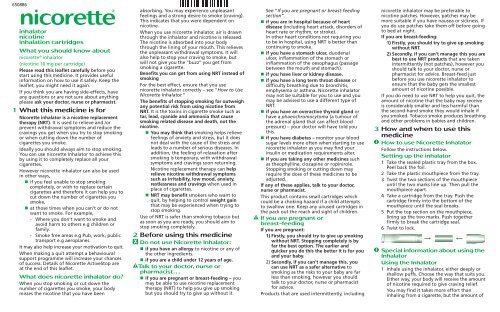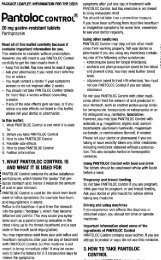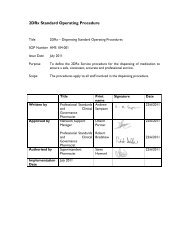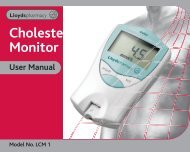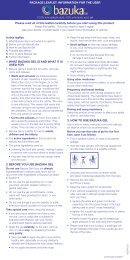View Patient Information Leaflet
View Patient Information Leaflet
View Patient Information Leaflet
Create successful ePaper yourself
Turn your PDF publications into a flip-book with our unique Google optimized e-Paper software.
650886<br />
inhalator<br />
nicotine<br />
inhalation cartridges<br />
What you should know about<br />
nicorette ® inhalator<br />
(nicotine 10 mg per cartridge)<br />
Please read this leaflet carefully before you<br />
start using this medicine. It provides useful<br />
information on how to use it safely. Keep the<br />
leaflet, you might need it again.<br />
If you think you are having side-effects, have<br />
any questions or are not sure about anything<br />
please ask your doctor, nurse or pharmacist.<br />
1 What this medicine is for<br />
Nicorette inhalator is a nicotine replacement<br />
therapy (NRT). It is used to relieve and /or<br />
prevent withdrawal symptoms and reduce the<br />
cravings you get when you try to stop smoking<br />
or when cutting down the number of<br />
cigarettes you smoke.<br />
Ideally you should always aim to stop smoking.<br />
You can use nicorette Inhalator to achieve this<br />
by using it to completely replace all your<br />
cigarettes.<br />
However nicorette inhalator can also be used<br />
in other ways,<br />
� if you feel unable to stop smoking<br />
completely, or wish to replace certain<br />
cigarettes and therefore it can help you to<br />
cut down the number of cigarettes you<br />
smoke,<br />
� at those times when you can’t or do not<br />
want to smoke. For example,<br />
- Where you don’t want to smoke and<br />
avoid harm to others e.g children or<br />
family.<br />
- Smoke free areas e.g Pub, work, public<br />
transport e.g aeroplanes.<br />
It may also help increase your motivation to quit.<br />
When making a quit attempt a behavioural<br />
support programme will increase your chances<br />
of success. Details of Nicorette ActiveStop are<br />
at the end of this leaflet.<br />
What does nicorette inhalator do?<br />
When you stop smoking or cut down the<br />
number of cigarettes you smoke, your body<br />
misses the nicotine that you have been<br />
absorbing. You may experience unpleasant<br />
feelings and a strong desire to smoke (craving).<br />
This indicates that you were dependent on<br />
nicotine.<br />
When you use nicorette inhalator, air is drawn<br />
through the inhalator and nicotine is released.<br />
The nicotine is absorbed into your body<br />
through the lining of your mouth. This relieves<br />
the unpleasant withdrawal symptoms. It will<br />
also help to stop your craving to smoke, but<br />
will not give you the ’’buzz’’ you get from<br />
smoking a cigarette.<br />
Benefits you can get from using NRT instead of<br />
smoking<br />
For the best effect, ensure that you use<br />
nicorette inhalator correctly – see “How to Use<br />
Nicorette Inhalator.”<br />
The benefits of stopping smoking far outweigh<br />
any potential risk from using nicotine from<br />
NRT. It is the toxins in cigarette smoke such as<br />
tar, lead, cyanide and ammonia that cause<br />
smoking related disease and death, not the<br />
nicotine.<br />
� You may think that smoking helps relieve<br />
feelings of anxiety and stress, but it does<br />
not deal with the cause of the stress and<br />
leads to a number of serious diseases. In<br />
addition, the feeling of relaxation after<br />
smoking is temporary, with withdrawal<br />
symptoms and cravings soon returning.<br />
Nicotine replacement therapy can help<br />
relieve nicotine withdrawal symptoms<br />
such as irritability, low mood, anxiety,<br />
restlessness and cravings when used in<br />
place of cigarettes.<br />
� NRT may benefit smokers who want to<br />
quit, by helping to control weight gain<br />
that may be experienced when trying to<br />
stop smoking.<br />
Use of NRT is safer than smoking tobacco but<br />
as soon as you are ready, you should aim to<br />
stop smoking completely.<br />
2 Before using this medicine<br />
X Do not use Nicorette Inhalator:<br />
� if you have an allergy to nicotine or any of<br />
the other ingredients.<br />
� if you are a child under 12 years of age.<br />
! Talk to your doctor, nurse or<br />
pharmacist…<br />
� if you are pregnant or breast-feeding – you<br />
may be able to use nicotine replacement<br />
therapy (NRT) to help you give up smoking<br />
but you should try to give up without it.<br />
See ”If you are pregnant or breast-feeding<br />
section”.<br />
� if you are in hospital because of heart<br />
disease (including heart attack, disorders of<br />
heart rate or rhythm, or stroke).<br />
In other heart conditions not requiring you<br />
to be in hospital, using NRT is better than<br />
continuing to smoke.<br />
� if you have a stomach ulcer, duodenal<br />
ulcer, inflammation of the stomach or<br />
inflammation of the oesophagus (passage<br />
between the mouth and stomach).<br />
� if you have liver or kidney disease.<br />
� if you have a long term throat disease or<br />
difficulty breathing due to bronchitis,<br />
emphysema or asthma. Nicorette inhalator<br />
may not be suitable for you to use and you<br />
may be advised to use a different type of<br />
NRT.<br />
� if you have an overactive thyroid gland or<br />
have a phaeochromocytoma (a tumour of<br />
the adrenal gland that can affect blood<br />
pressure) – your doctor will have told you<br />
this.<br />
� if you have diabetes – monitor your blood<br />
sugar levels more often when starting to use<br />
nicorette inhalator as you may find your<br />
insulin or medication requirements alter.<br />
� if you are taking any other medicines such<br />
as theophylline, clozapine or ropinirole.<br />
Stopping smoking or cutting down may<br />
require the dose of these medicines to be<br />
adjusted.<br />
If any of these applies, talk to your doctor,<br />
nurse or pharmacist.<br />
This product contains small cartridges which<br />
could be a choking hazard if a child attempts<br />
to swallow one. Keep any unused cartridges in<br />
the pack out the reach and sight of children.<br />
! If you are pregnant or<br />
breast-feeding<br />
If you are pregnant:<br />
1) Firstly, you should try to give up smoking<br />
without NRT. Stopping completely is by<br />
far the best option. The earlier and<br />
quicker you do this the better it is for you<br />
and your baby.<br />
2) Secondly, if you can’t manage this, you<br />
can use NRT as a safer alternative to<br />
smoking as the risks to your baby are far<br />
less than smoking, however you should<br />
talk to your doctor, nurse or pharmacist<br />
for advice.<br />
Products that are used intermittently, including<br />
nicorette inhalator may be preferable to<br />
nicotine patches. However, patches may be<br />
more suitable if you have nausea or sickness. If<br />
you do use patches take them off before going<br />
to bed at night.<br />
If you are breast-feeding:<br />
1) Firstly, you should try to give up smoking<br />
without NRT.<br />
2) Secondly, if you can’t manage this you are<br />
best to use NRT products that are taken<br />
intermittently (not patches), however you<br />
should talk to your doctor, nurse or<br />
pharmacist for advice. Breast-feed just<br />
before you use nicorette inhalator to<br />
ensure that the baby gets the smallest<br />
amount of nicotine possible.<br />
If you do need to use NRT to help you quit, the<br />
amount of nicotine that the baby may receive<br />
is considerably smaller and less harmful than<br />
the second-hand smoke they would inhale if<br />
you smoked. Tobacco smoke produces breathing<br />
and other problems in babies and children.<br />
3 How and when to use this<br />
medicine<br />
i How to use Nicorette Inhalator<br />
Follow the instructions below.<br />
Setting up the inhalator<br />
1 Take the sealed plastic tray from the box.<br />
Peel back the foil.<br />
2 Take the plastic mouthpiece from the tray.<br />
3 Twist the two sections of the mouthpiece<br />
until the two marks line up. Then pull the<br />
mouthpiece apart.<br />
4 Take a cartridge from the tray. Push the<br />
cartridge firmly into the bottom of the<br />
mouthpiece until the seal breaks.<br />
5 Put the top section on the mouthpiece,<br />
lining up the two marks. Push together<br />
firmly to break the cartridge seal.<br />
6 Twist to lock.<br />
i Special information about using the<br />
Inhalator<br />
Using the Inhalator<br />
1 Inhale using the inhalator, either deeply or<br />
shallow puffs. Choose the way that suits you.<br />
Either way, your body will receive the amount<br />
of nicotine required to give craving relief.<br />
You may find it takes more effort than<br />
inhaling from a cigarette, but the amount of
650886<br />
nicotine you absorb through the lining of<br />
your mouth is the same whether you take<br />
deep or shallow puffs.<br />
2 It is up to you how many inhalations (puffs)<br />
you take, how often you take them and for<br />
how long.<br />
3 Each cartridge will provide you with about<br />
20 minutes of intense use. You can divide this<br />
time how you like. For example, you could<br />
use a cartridge for two 10 minute inhalation<br />
periods. Or you could use a cartridge for 10<br />
minutes on waking and then for two periods<br />
of five minutes later on in the day.<br />
Once the cartridge is used up, you will need<br />
to change it.<br />
Changing a cartridge<br />
1 Open the mouthpiece as in step 3 of Setting<br />
up the inhalator. Pull out the cartridge and<br />
dispose of it safely.<br />
2 Put a new cartridge into the inhalator as in<br />
steps 4-6 of Setting up the inhalator.<br />
Dosage and temperature<br />
Nicorette inhalator works best at room<br />
temperature and it is best not to use the<br />
inhalator in the cold.<br />
In cold surroundings (below 15°C or 59°F) you<br />
may have to inhale more often to get the same<br />
amount of nicotine as when using the<br />
inhalator at room temperature. When you are<br />
in surroundings above 30°C or 86°F, you should<br />
inhale less often to avoid taking in too much<br />
nicotine.<br />
i When to use the Inhalator<br />
If you are able to stop smoking you should use<br />
the inhalator, when needed, in place of<br />
cigarettes. As soon as you can (this could be<br />
after a number of weeks or months) you<br />
should reduce the number of cartridges until<br />
you have stopped using them completely.<br />
If you are unable to stop smoking or do not<br />
feel ready to quit at this time, you should<br />
replace as many cigarettes as possible with the<br />
inhalator. There are toxins in cigarettes that<br />
can cause harm to your body. Nicorette<br />
inhalator provides a safer alternative to<br />
smoking, for both you and those around you.<br />
Reducing the amount of cigarettes may also<br />
help you to become more motivated to stop<br />
smoking. As soon as you are ready you should<br />
aim to stop smoking completely.<br />
You can also use the inhalator on those<br />
occasions when you can’t or don’t want to<br />
smoke e.g. Social situations such as a party, in<br />
the pub or when at work.<br />
When making a quit attempt behavioural<br />
therapy, advice and support will normally<br />
improve the success rate. If you have quit<br />
smoking and want to stop using the inhalator<br />
but are finding this difficult you should contact<br />
your doctor, nurse or pharmacist for advice.<br />
i Below is the dosage information<br />
for nicorette inhalator.<br />
Age Dose<br />
Adults and children As needed up to a maximum<br />
aged 12 years and over of 12 cartridges per day<br />
� Do not use more than 12 cartridges per day.<br />
� The frequency with which you use the cartridges<br />
and the length of time it lasts will depend on<br />
how many cigarettes you smoked and how<br />
strong they were.<br />
! If you have used Nicorette Inhalator<br />
too much<br />
If you have used more than the recommended<br />
number of cartridges, you may experience<br />
nausea (feeling sick), salivation, pain in your<br />
abdomen, diarrhoea, sweating, headache,<br />
dizziness, hearing disturbance or weakness.<br />
� If you do get any of these effects contact a<br />
doctor or your nearest hospital Accident and<br />
Emergency department immediately. Take<br />
this leaflet and the pack with you.<br />
! If a child uses an inhalator or<br />
swallows a cartridge<br />
� Contact a doctor or your nearest hospital<br />
Accident and Emergency department<br />
immediately if a child under 12 years uses<br />
your inhalator, or chews, sucks or swallows a<br />
cartridge. Take this leaflet and the pack with<br />
you.<br />
Nicotine inhalation or ingestion by a child<br />
may result in severe poisoning.<br />
4 Possible side-effects<br />
Like all medicines, nicorette inhalator can have<br />
side-effects. As many of the effects are due to<br />
nicotine, they can also occur when nicotine is<br />
obtained by smoking.<br />
Effects related to stopping smoking<br />
(nicotine withdrawal)<br />
You may experience unwanted effects because by<br />
stopping smoking you have reduced the amount<br />
of nicotine you are taking. You may also<br />
experience these effects if you under use nicorette<br />
inhalator cartridges before you are ready to<br />
reduce your nicotine intake.<br />
i These effects include:<br />
� irritability or aggression,<br />
� feeling low,<br />
� anxiety,<br />
� restlessness,<br />
� poor concentration,<br />
� increased appetite or weight gain,<br />
� urges to smoke (craving),<br />
� night time awakening or sleep disturbance<br />
� lowering of heart rate.<br />
Effects of too much nicotine<br />
It is possible to inhale too much nicotine if you use<br />
the inhalator in very warm surroundings. You may<br />
also get these effects if you are not used to<br />
inhaling tobacco smoke.<br />
! These effects include:<br />
� feeling faint<br />
� feeling sick (nausea)<br />
� headache<br />
Side-effects for Nicorette Inhalator<br />
Very common side-effects:<br />
(more than 1 in every 10 people are affected)<br />
� headache<br />
� cough<br />
� irritation of the mouth or throat<br />
Common side-effects:<br />
(less than 1 in every 10 people are affected)<br />
� dizziness<br />
� nasal congestion<br />
� stomach discomfort<br />
� hiccups<br />
� feeling sick (nausea)<br />
� sickness (vomiting)<br />
Uncommon side-effects:<br />
(less than 1 in every 100 people are affected)<br />
� chest palpitations<br />
Very rare side-effects:<br />
(less than 1 in 10,000 people are affected)<br />
� abnormal beating of the heart<br />
➤ If you notice these or any other unwanted<br />
effects not listed in this leaflet tell your doctor,<br />
nurse or pharmacist.<br />
➤ When you stop smoking you may also develop<br />
mouth ulcers. The reason why this happens is<br />
unknown.<br />
5 Cleaning, storing and disposal<br />
Cleaning the inhalator<br />
Clean the empty mouthpiece several times a<br />
week by rinsing it in water.<br />
Storing the inhalator and cartridges<br />
� Keep nicorette inhalator out of the reach and<br />
sight of children and animals. Nicotine in high<br />
doses can be very dangerous and sometimes<br />
fatal if taken by small children.<br />
� Do not store above 30°C.<br />
� Do not use nicorette inhalator after the ’Use<br />
before’ date shown on the carton.<br />
Disposal<br />
Dispose of your used inhalator cartridges safely.<br />
When a cartridge is used up, it is very<br />
important that you dispose of the empty<br />
cartridge carefully as it still contains some<br />
nicotine fixed to the plug. This nicotine is not<br />
available for inhalation but could be harmful<br />
to children or pets if swallowed or sucked.<br />
You can return the empty cartridge to the foil<br />
tray then dispose of all the empty cartridges<br />
with your household rubbish.<br />
6 Further information<br />
What’s in this medicine?<br />
The active ingredient is Nicotine.<br />
Other ingredients are: Menthol.<br />
What the medicine looks like<br />
Nicorette inhalator consists of a plastic<br />
mouthpiece into which you insert a tube-like<br />
cartridge containing 10 mg of nicotine, the active<br />
ingredient, held in a porous plug.<br />
The plug also contains menthol to give the<br />
nicotine a slight minty flavour.<br />
Nicorette Inhalator is supplied as either a starter<br />
or a refill pack.<br />
The starter pack contains a plastic tray sealed with<br />
foil containing 6 cartridges and a plastic mouthpiece.<br />
The refill pack contains a mouthpiece and 42<br />
cartridges.<br />
Who makes Nicorette Inhalator?<br />
The Product Licence holder is McNeil Products Ltd,<br />
Maidenhead, Berkshire, SL6 3UG, UK.<br />
The manufacturer is McNeil AB, Helsingborg,<br />
Sweden.<br />
This leaflet was revised in June 2010. ©<br />
<strong>Information</strong> about Nicorette<br />
ActiveStop<br />
Nicorette ActiveStop is a personalised support<br />
programme which works with Nicorette to support<br />
you, with the aim of helping you give up smoking.<br />
All you need is internet access and a mobile<br />
telephone.<br />
Call 0800 244 838 for information.


